Executive Summary
The following report carries out a comprehensive analysis of two pitot static tester models. The models include the Automated Pitot Static Tester Model 6300 and the Military Pitot Static Tester Model 6300-M3. Both of them serve the same purpose of generating and measuring pressure or partial vacuums while simulating aircraft altitude and speeds.
Consequently, operators are able to determine the functionality of various aircraft equipments and parameters such as airspeed and altitude. Both models are very similar in design, size and standards, and even suitable for similar types of aircrafts.
However, the Military Pitot Static Model 6300-M3 proves more superior in relation to its functionalities, since it has relatively higher specifications than the model 6300. The report proposes that the Military Pitot Static Model is much better than the 6300 model. However, diligence should be observed depending on the aircraft that is being tested.
Automated vs. Military Pitot Static Tester: A Comparative Analysis
Introduction
Pitot static testers are basically used in evaluating the pitot and static systems of aircrafts. They are used to detect any malfunctions, such as leaks. They are also used in testing the operation and function of pitot static systems. Such functionalities include operation and setting of engine pressure ratio and airspeed.
Others entail manifold pressure indicators and associated units. Pitot static testers also known as air data testers are pressure generators and pressure management which simulates the altitude, as well as aircraft speeds on on-board equipments [1]. Apparently, pitot static testers are very essential equipments in aircrafts.
Purpose
When making decisions about the model which may be appropriate for a particular plane, it may be necessary to understand their specifications so that it may be clear how different models operate. This will be the focus of the study. This research will narrow down to two models that are popularly in use today.
The two that will be compared are Model 6300: Automated Pitot Static Tester and Model 6300-M3: Military Pitot Static Tester. The aim is to determine why given models have become popular with different types of planes. This way, a company can be in a position to make an informed decision when purchasing the product.
Background Information
Automated Pitot Static Tester Background
The first pitot static testers were developed as early as 1963 by the Intercontinental Dynamics Corporation, by Sam Sharko, Joshua Salem and Johnn Andresen Junior. The series of model 6300 Pitot Static Testers are produced by Laversab Aviation Systems up to date [3].
Military Pitot Static Tester Background
Model 6300-M3: Military Pitot Static Tester were also developed from the automated pitot static testers Laversab Aviation Systems.
Mechanisms Description
The following subsections describe the technical aspects of the automated pitot static tester model 6300 and the military pitot static tester model 6300-M3. Both models of pitot static testers were designed and developed by Laversab Aviation Systems developers, a company specializing in the development of aircraft testing equipments.
Automated Pitot Static Tester Model 6300
Automated Pitot Static Tester Model 6300 Appearance
Both the automated pitot static tester model 6300 and the military pitot static tester model 6300-M3 are very similar in appearance, however their technical aspects differ. The automated static tester has a unique design. It is linked to the craft’s static system.
The 6300 automated pitot static tester has a remote unit which is detached from the main body of the testing equipment [3]. The system also has air data test which entails a built-in vacuum, emergency manual bleed-down valves, as well as pressure pumps [3]. The model is small and lightweight, making very portable.
The main apparent physical features of the 6300 pitot static tester are the main unit and the remote unit. The dimensions of 6300 automated pitot static tester are as follows:
Main unit: 22” x 14”x 9”/40lbs
Remote unit: 7”x 8” x 1 lb [3].
Using the lightweight small remote unit, the user of the equipment can operate it from the aircraft’s cockpit, in testing the complete pitot and static system of the aircraft air data computers, altimeters, airspeed of Mach indicators, autopilots and climb indicators [3]. The unit is built such that it requires simple connection to power, and then the pitot and static hose, then it is ready for use [4]. In addition, the unit has RS232 interface, through which all commands of the system are entered either by dialing them or through the remote controller [4].
Figure 1 below indicates the physical appearance of the 6300 Automated Pitot Static Tester:
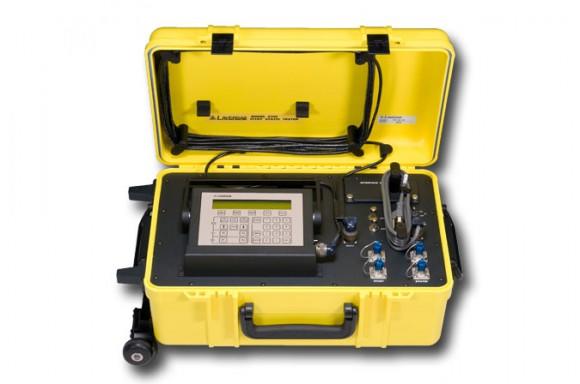
Figure 2 indicates the appearance of the Military Pitot Static Tester Model 6300-M3Source: [3]
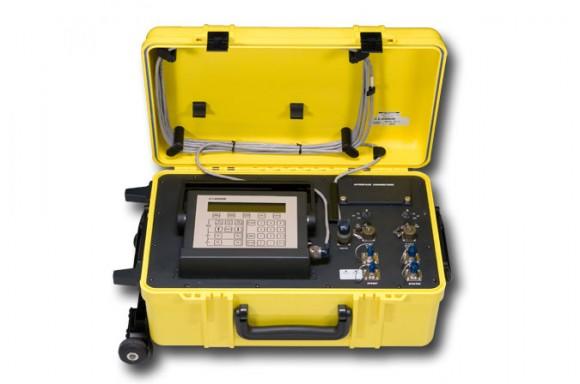
The figures indicate the similarity between the Automated Pitot Static Tester Model 6300 and the Military Static Tester Model 6300-M3. Apparently, the two models are indistinguishable from their physical appearance only. The names of the models also indicate that their design is similar. However, their differences are in relation to specifications and functionality levels.
Automated Pitot Static Tester Model 6300 Components
Both the automated pitot static tester 6300 and the military pitot static tester have similar main components. The functionalities of the components are also similar, only differing in essential specifications.
The automated pitot static tester is made up by a number of major components. They include the following:
- Pressure and Vacuum System. It is one of the main elements of the network. It is made up of an independent pressure and vacuum system. It also contains diaphragm pumps. The components are aimed at enhancing the reliability of the system. The pressure system is designed in a manner that it has membrane dryer fitted with a filter, which provides clean air for the complete system [3].
- The Remote Unit. The remote unit refers to the operator interface which is utilized by the user [3]. The remote unit is built with on and of buttons, which are used are used to control the entire tester [4]. In addition, the remote unit is designed such that it is light for portability and small so that it can be fitted on the aircraft cockpit [3]. The remote unit also has various valid parameters, including airspeed, climb and altitude, which are displayed on the tester’s single screen [3].
- Manual Vent. The manual vent is a component of the tester which is fitted with manual metering valves that enable the aircraft/system to be manually vented, in case power loss is experienced [3].
- RS232 Interface Connector. The connector is a standard DB-9 female connector utilized for the serial RS 232 interface [4]. It links the interface connector to the “COM” port. As such, a communication system can be established. Consequently, the port is utilized in downloading “profiles” directly from the computer [3].
- IEEE-488 Interface Connector. The option of IEEE-488 is only provided in the 6300 model, and it located under the interface connectors access panel [3]. Since it is a standard 24-pin interface connector, this enables communication with other models such as the 6300-M3.
- Pitot Ports. The pitot ports provide two internally connected outputs, fitted with #4 AN fittings [3]. The ports are connected through a hose to the aircraft pitot port [4]. The ports provide the connection between the tester and the pitot static system.
- Static Ports. The static ports are internally connected, and provide two ports for static output [3]. The ports and fitted with #6 AN fittings, and at least one of them must connected with the aircraft’s static port through a hose [3].
- Remote Unit Top Panel. Figure 3 shows the front panel of the tester’s remote unit. The unit top panel is fitted with an LCD display which has 4 lines, each with 40 characters [3]. The top panel also has 5 operational keys. The functions of “Next Screen” and “Previous Screen” are also provided on the remote unit top panel, which facilitate toggling between various operating screens of the model [4].
Figure 3 shows the automated pitot static tester model 6300 remote unit top:
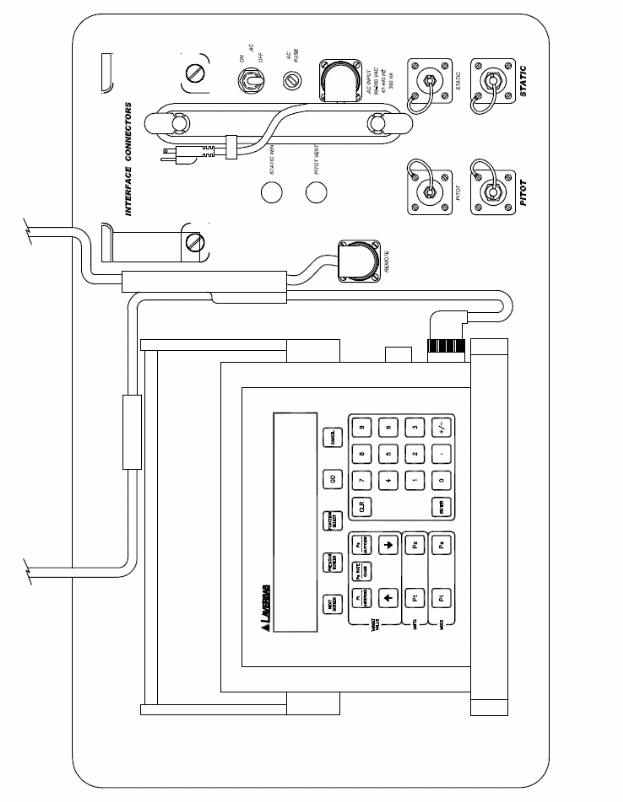
Automated Pitot Static Tester Model 6300 Tester Operation
The automated pitot static tester model 6300 is a high accuracy automated pressure controller, specifically designed for controlling air data parameters including airspeed, altitude climb and Mach [4]. Apart from the fitted internal pressure and vacuum pumps, the tester also has two high accuracy transducers which take pressure measurements in the range of 0 to 38 in Hg absolute static output, and 0 to 60 in Hg absolute static output [3].
The operator has to simply connect to the tester to power, as well as the pitot and static hoses, and then the unit is operational [4]. The profiles help the machinist to carry out tests using a single button from the remote panel. In addition, all the commands to the tester can be carried out using the RS232 interface [4].
Military Pitot Static Tester Model 6300-M3
Military Pitot Static Tester Model 6300-M3 Appearance
The appearance of military static tester model 6300-M3 is similar to that of the automated pitot static tester model 6300, since they are from the same design. The tester is also automated and has a remote unit which is small and lightly built to facilitate direct connection to the aircraft’s Pitot and Static system [3].
The main apparent features of the Military Pitot Static Tester Model 6300-M3 are also the remote unit and the main unit. The main unit and remote unit dimensions of the tester are as follows:
Main unit: 22” x 14”x 9”/44 lbs
Remote unit: 7”x 8”x 2/1/b [3].
Apparently, the Military Pitot Static Tester Model 6300-M3 is slightly larger and heavier than the Automated Pitot Static Tester model 6300. Please refer to figure 2 shown earlier for the appearance of military Pitot Static Tester Model 6300-M3.
Military Pitot Static Tester Model 6300-M3 Components
The main components of Military Pitot Static Tester Model 6300-M3 are also similar to those of Automated Pitot Static Tester Model 6300, with slightly varying specifications. The main components of this tester include:
- Profiles Feature. The profiles feature allows for downloading of profile set-points from a PC, hence enabling the user to operate the tester using a single key [3]. The tester profiles capacity is up to 50 points, and 20 profiles are stored in the unit [2].
- Pressure and Vacuum Source. The tester has in-built high-capacity dual vacuum and pressure pumps, which provide a source of vacuum and pressure for the unit [3]. It has a filter and a membrane dryer. The components supply the system with clean and dry air.
- Leak Checks. The tester has Pitot and Static leak checks which can either be performed simultaneously or independently [3]. The tester also has three leak timers, which can be programmed such that they perform times leak checks between intervals of 1-20 minutes [3].
- Manual Vent. The manual vent comprises of precision measuring valves, which enable manual venting of the pitot static system in case of power loss [3].
- Remote Unit. It is another component of the system. It refers to the operator’s interface. The unit is used to turn the tester on and off, as well as calibrating other parameters including airspeed, climb and altitude [3]. The parameters are then displayed on a single screen built into the remote simultaneously [3].
- Indicator LED’s (Light Emitting Diodes). The tester has two indicator LEDs. They are located to the left of the Pitot port [3]. It READY LED is switched on when power is supplied to the 6300-M3 [2]. On the other hand, HEATERS LED turns yellow and then ON, following optional energizing of the internal heaters [3].
Other components of the Military Pitot Static Tester such as RS232 interface connector, encoder interface connector, static and pitot vents among others have similar functions to those of the Automated Pitot Static Tester Model 6300.
Figure 4 on the other hand indicates Military Pitot Static Tester Model 6300-M3 top panel:
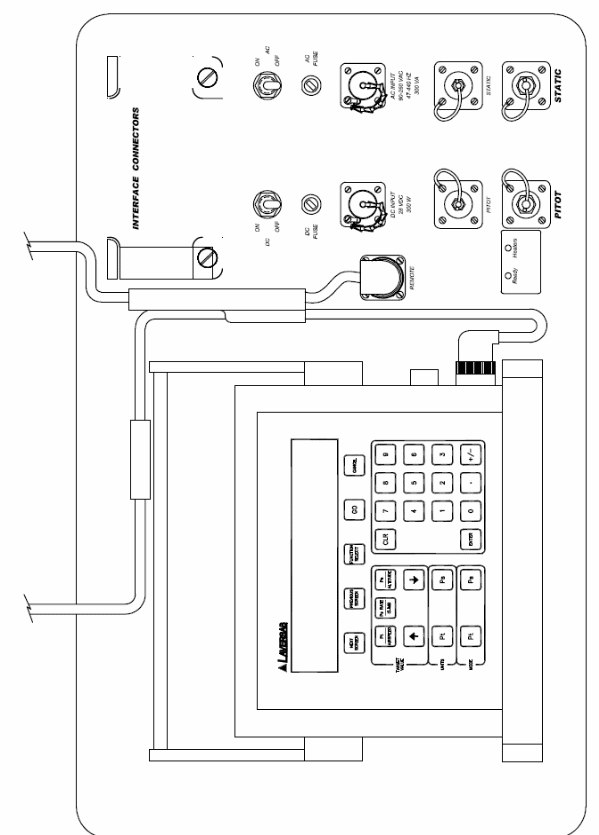
Figure 5 below shows the front panel of the Military Pitot Static Tester Model 6300-M3 remote unit top:
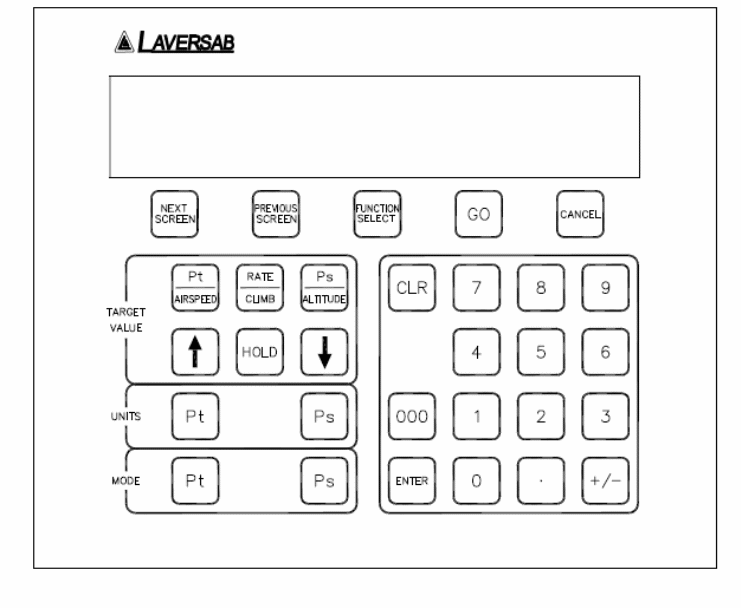
Military Pitot Static Tester Model 6300-M3 Operation
The tester is essentially operated through the RS232 interface, which is similar to the automated pitot static tester model 6300. To ready the tester for use, the power and remote components are connected, and then the Pitot and Static outputs are connected to the aircraft, making it ready for use [3].
The 6300-M3 similar to the 6300 model comes with dual transducers which are of high accuracy, measuring pressure ranges between 0 to 38 Hg absolute static output [3]. Absolute pitot output on the other hand is 0 to 100 in Hg [3]. The transducers are designed in manner that they accurately determine the pressure of dry air over an ambient temperature of range -400 C to 550C [3].
The 6300-M3 model also enables users to control altitude either in meters or feet, climb in meter per minute or feet per minute, and then airspeed in mach, knots, and kilometers or meter per hour [3]. The operation of the Pitot Static Testers Models 6300 and 6300-M3 are hence the same, only differing in capability and specifications.
Comparative Analysis
The following subsections carry out a comparison between the Automated Pitot Static Tester Model 6300 and the Military Pitot Static Tester Model 6300-M3. The comparison is in terms of the testers’ performance, effectiveness, and cost.
Operational Goal
The operational goal of pitot static testers irrespective of the model is to generate and measure pressure while simulating altitude and speed of aircrafts on on-board equipments. Connecting the various onboard equipments to the pitot static tester enables simulation of flight conditions, hence determining whether an aircraft is suitable and safe to fly.
Assessment Criteria
Performance
The pitot static tester must be able to simulate and withstand extreme flight conditions, so as to establish optimal performance of the various aircraft equipments.
Efficiency
Effective of a pitot static tester is determined by the ability to give precise and accurate results, based on the simulation variables and parameters.
Cost
Although cost is not a major factor in assessing pitot static tester, it is essential that the quality of service offered is reflected in the value.
Discussion
The following subsections assesses the by which each of the compared pitot static models meets the assessment criteria.
Automated Pitot Static Tester Model 6300 Discussion
The model is highly accurate, and it meets RSVM (Reduced Vertical Separation Minima) requirements, hence suitable for all aircrafts compliant to these standards. Among the outstanding features of this model include leak checks and air-data system automated checks, which are very effective for fixed wing-aircraft, UAV’s (Unmanned Aerial Vehicles), and helicopters.
The airspeed range of this model is 0-650 knots, operating temperatures of 00c-500C and altitude of -4000 ft. to 60,000 ft [3]. The cost of the model retails at an estimated price of $10 000, hence making it relatively expensive. Consequently, the model is effective for aircrafts which are not very fast, and which fly at relatively low heights, for instance commercial airlines.
Military Pitot Static Tester Model 6300-M3 Discussion
The model also meets the RSVM requirements, hence suitable for aircrafts which are compliant to the standards. Among the outstanding features of this model are also the automated air-data-system accuracy checks and leak checks. In addition, the model is made with the needs of military aircrafts in mind, especially considering it operating temperature range of -400C- 550C [3]. The price of the mode is also relatively high price, estimated at $11 900.
The model is also more ideal for aircrafts which are more likely to be subject to extreme conditions, outside the range of model 6300. For instance the model’s airspeed range of 0-110 knots, and altitude of -4000 to 100 000 feet [3]. Consequently, the model is more ideal for military applications for instance in fighter aircrafts.
Concluding Recommendations
The report recommends that each model should be chosen based on the aircraft capabilities and specifications. Apparently, both models are from the same family of designs, automated, sand RSVM compliant. Every aircraft has specifications such as altitude and airspeed and limits which should not be exceeded.
However, to be on the safe side, Military Pitot Static Tester Model 6300-M3 can be chosen for its capability to simulate more extreme conditions. Precision and accuracy are the most crucial elements in flying, hence the more capabilities and precision, as well as higher accuracy, the better. Prices of both models are however relatively high but worthwhile, considering the functions of the testers.
References
- ATEQ, (2013). “Pitot Static Testers & Adaptors”. Hangar.
- AvionTeq, (2010). “Laversab Model 6300-M3 Military Pitot Static Tester”. Van Nuys.
- LAVERSAB, (2014). “Model 6300-M3: Military Pitot Static Tester”. Aviation Systems.
- LAVERSAB, (2014). “RVSM Pitot Static Tester Model 6300 – 2 Outputs”. Aviation Systems.